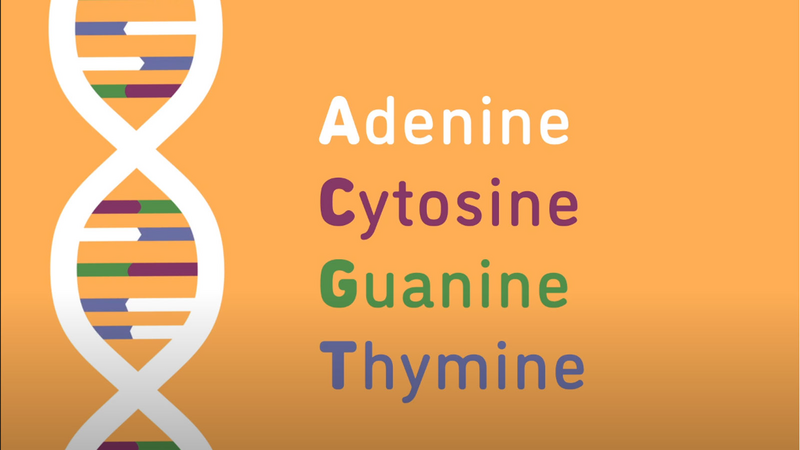Settings
Save and close
Think of this code as an instruction manual for making all the proteins that form our bodies and help them thrive. The information coded in DNA is hereditary, meaning that it passes from parent to child. Because of this inheritance, DNA also determines our traits: including how we are shaped and how similar we look to our parents. These traits coded in DNA will always get passed on from generation to generation.
The DNA that determines heritable traits is found in the nucleus of every single cell of our bodies. DNA is made up of two intertwined strands linked together by pairs of building blocks, known as bases, adenine, cytosine, guanine, and thymine. Bases make up the rungs of DNA's ladder-like double-stranded structure. When a base joins the side of the ladder, a nucleotide is formed. When nucleotides pair with an opposite DNA strand, the ladder is complete. An A base always pairs with a T base, and a C base always pairs with a G base. By reordering these four bases in long DNA sequences, an infinite number of combinations is possible.
This is why there is a unique DNA sequence or code for every protein in our bodies, including those that determine our traits. For example, a sequence of ATTTTG might instruct for blue eyes, while a sequence of TTTTTG might instruct for brown. By understanding how DNA is formed and knowing what unique DNA sequences encode each protein, we can start understanding how DNA sequences affect how we function and how we look. This is because DNA is the instruction manual for all the proteins that form our body and help it thrive for hopefully 100 years or more.

Endometriosis is a fairly common gynecological condition that affects 200 million people with uteruses worldwide. So what is this condition, exactly, and what can be done about it?
View more
We all want to live long lives, but not at the expense of our health!
View more

The trillions of bacteria, fungi and viruses that live on the skin all over our bodies is part of the microbiome.
View more
Discover what genetic resilience is and how our genetic makeup can protect us from disease in this Minute to Understanding from The Jackson Laboratory!
View more
Mutations in our genes can cause life-threatening diseases, and sometimes there is no drug or surgery available for your doctor to prescribe. Enter gene therapy.
View more
Learn how epigenetic changes can affect an individual — without physically changing their DNA sequence.
View more
The difference between genetics and genomics is not just the letter "O."
View more
Every person in the world is different. We all have physical characteristics and quirks that make us unique. But what, biologically, makes us who we are?
View more
Discover what DNA is and how it serves as the genetic instruction manual for life. Learn how DNA sequences determine traits and pass heritable information from one generation to the next.
View more
What are telomeres? Telomeres are structures made from DNA sequences and proteins found at the ends of chromosomes. They cap and protect the end of a chromosome like the end of a shoelace.
View more
Explore bite-sized science with Minute to Understanding. Quick, easy-to-remember videos simplify complex scientific terms and breakthroughs. Perfect for staying informed on the latest advancements.
View more
Explore DNA variants and discover how mutations during DNA replication make each organism unique. Learn about their role in genetic variation and their potential impact on life.
View more
Discover the role of chromosomes in cell division and genetic data storage. Learn how these DNA-packed structures enable proper cell function and ensure life’s continuity.
View more